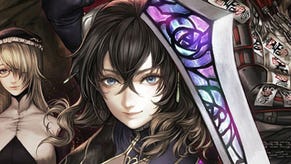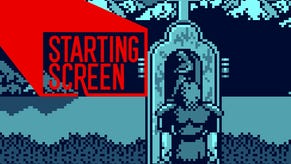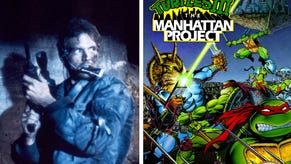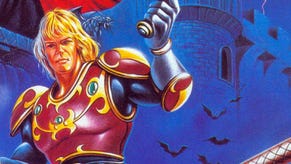Castlevania: Lords of Shadow 2 PS3 Review: Dracula Defanged
Slaying Satan's minions may be a blast, but questionable design choices all too often drive a stake through the heart of this tale.
This article first appeared on USgamer, a partner publication of VG247. Some content, such as this article, has been migrated to VG247 for posterity after USgamer's closure - but it has not been edited or further vetted by the VG247 team.
A year ago, I asked Castlevania: Lords of Shadow 2 producer Dave Cox if he and his team were feeling any additional pressure to deliver a superior sequel after exceeding fans' expectations after MercurySteam's first take on Castlevania, 2010's Lords of Shadow. "We sort of came out of nowhere last time," he told me. "This time everyone's kind of got expectations, and we've got to exceed them. I think that's the real pressure on the team."
As someone who's been dodging floating medusa heads and splashing holy water on bone-tossing skeletons since doing meant being tethered to a NES, I finished the first 30 or so minutes of Lords of Shadow 2 confident Cox and his team had indeed overcome sequelitis. The game begins as Gabriel Belmont – newly christened Dracula in the wake of Lords of Shadow's final plot twist – rises from his throne, polishes off a chalice of crimson plasma, and greets the knights that've just reduced his door to splinters with a one-liner and a case of kick-ass.
This bold opening serves as the title's tutorial, teaching players how to use Dracula's trio of primary weapons before unleashing them on a gold-plated paladin and traversing a screen-filling titan. With its seamless blending combat and platforming – two elements that never mingled in the last game – LoS2's first major battle feels like a potential-packed promise of what's to come. Yet no more than two hours after this adrenaline-spiking encounter, I find myself in an air duct, possessing the body of a rat that's attempting – unsuccessfully – to hop over a sparking electrical wire so it can gnaw on a tangle of circuits.
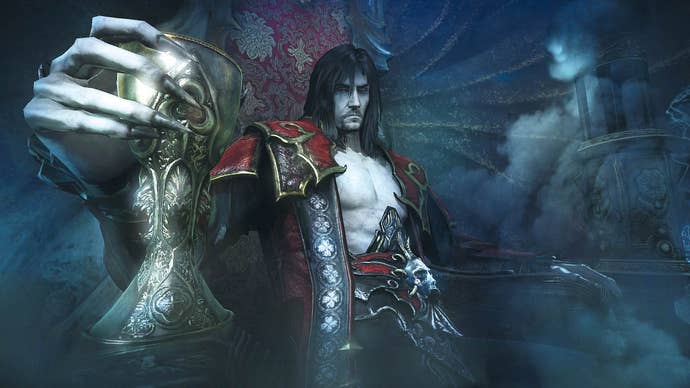
To be fair, Dracula's descent from titan-thwarting badass to wire-chewing rodent isn't indicative of my entire time with the game; it is, however, primary among a handful of flaws that sucked the air from my initial enthusiasm. The fact such an empowered character is continually bested by a malfunctioning wire he just can't seem to clear with his tiny rat legs is only a minor part of a major problem. The latter is the game's stubborn insistence that stealth is sometimes the best strategy. At a number of points during the campaign – even after Dracula regains the powers he's stripped of early on – players are forced to trade his arsenal of enemy-eviscerating skills for the ability to possess mice and men. In addition to not being optional in most cases, these sections are frustrating and tedious, often requiring multiple attempts to complete. Even if the shadow-skulking were moderately entertaining, why is a character who tears hearts from the chests of monstrosities ten times his size suddenly scared of a grunt with a gun?
Thankfully, Dracula doesn't spend nearly as much time neutered as he does reducing Satan's minions to wet smears. As demonstrated in an early scene in which he eviscerates a terrified family of three, Gabriel Belmont is no longer a nice guy. Of course, Satan's army is even meaner, providing plenty of evil-doing fodder for the Prince of Darkness to dig his fangs into. While the stealth sections suffer, combat encounters soar thanks to a deep and satisfying system that should feel comfortably familiar to anyone who carved up hordes in last year's God of War: Ascension or DmC.
In addition to the anti-hero's signature blood whip, players can open baddies wide open with a sword attack that leeches life from targets and a claw that breaks their armor like peanut brittle. All three of these powers have skill trees with plenty of opportunities to learn and upgrade new moves with earned experience points. The sword and claws also drain power from their own individual meters, which must be refilled by collecting orbs. While these mechanics and systems closely resemble those featured in other third-person action titles, they're implemented well enough that I didn't mind the familiarity.

More than that, though, I appreciated the mastery system, a significant inclusion that separates LoS2's combat from its combo-happy contemporaries. Where similar games' unlockable and upgradeable abilities go largely ignored in favor of a few reliable death-dealers, I was encouraged to master Dracula's skills because doing so ultimately made my weapons more powerful. It's a small touch, but one that makes the difference between button-mashing and delving into the depths of the combat system. Toss in consumable relics, like ones that slow time, replenish health, and unleash a dragon capable of barbecuing all baddies in its path, and players never suffer from a shortage of ways to show Satan's army the door.
While much of the combat is of the standard clear-a-room variety, LoS2 is also brimming with bigger threats. More ghastly than gothic, the varied line-up of grotesque threats wouldn't look out of place wandering the streets of Silent Hill. This might disappoint franchise purists hoping to go toe-to-talon with more traditional castle-dwelling monsters, but I dug the darker, twisted tone of the creature designs. This more macabre approach rears its ugly mug in other areas as well; on top of the aforementioned feeding scene, the game displays its darkness every time Dracula happily opens his wrists in some form of ritual sacrifice or shoves a hand into a torture device dubbed the "pain box."
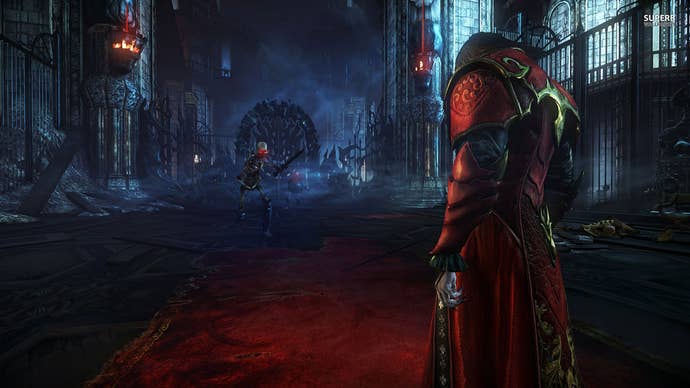
Unfortunately, those examples represent the extent of the game's artistic ambition. Most of the action unfolds in a modern-day London-like city or back at Dracula's castle. The latter is too dark and muddy, only occasionally sporting the sort of eye-catching detail and slick effects we've come to expect from late-gen console efforts; and the former's pretty backgrounds – dotted by steeples, stained glass, gargoyles, and other appealing Gothic architecture – are just a tease, as much of your time is spent in generic sewers, warehouses, and underground parking structures. You'll also spend your fair share of downtime riding elevators, a device too often used to gloss over lengthy load times. The only thing more depressing than watching Dracula scurry about as a rat is seeing him pace back and forth in an empty elevator.
As much as I enjoyed besting hell's henchman (and their horned, clawed, and fanged bosses) with the twitchy-yet-deep combat system, the thrill of painting the world in gore wasn't enough to outshine the title's shortcomings. On top of the undercooked stealth and subpar environmental visuals, the story's a disjointed mess that swaps you between city and castle with seemingly little rhyme or reason. The narrative arch does spring a few surprises and character appearances fans will surely appreciate, but more often than not the story and gameplay seem less interested in supporting each other and more concerned with tossing something new the player's way before they become bored. The same goes for the much-touted Metroidvania and platforming elements, both of which feel less like organic extensions of the story and action and more like features tacked on to appease a vocal fan base. Compounding this problem is the castle's confusing level design, which often shamed me into sticking to the critical path for fear of getting Dracula lost in his own home.
Check your expectations set by Lords of Shadow at the door and its sequel will provide a weekend's worth of fun boss battles and fan-pleasing call-outs to the series' past. Those hoping for a superior follow-up, however, might have to wait until Dracula makes his next-gen debut.
The Details
- Visuals: Cool creature designs range from creepy to nightmare-conjuring, but environments are often bland and boring, only sporadically displaying sparks of artistic inspiration.
- Sound: Combat yields the expected, but satisfying sounds of breaking bones and flayed flesh. Dialogue – despite Robert Carlyle's and Patrick Stewart's best efforts – however, comes off hammy.
- Interface: Combat incorporates nearly every button and stick, but is implemented intuitively. Stealth mechanics feel unpolished, resulting in more frustration than fun.
- Lasting Appeal: Slogging through some campaign-stretching filler, seeking every collectable, and tackling every challenge will net completionists a good 20-plus hours of gameplay.
ConclusionCastlevania: Lords of Shadow 2 offers a solid third-person action experience in the vein of God of War and Devil May Cry. Outside of combat, it suffers from poor design decisions, dated visuals, and a disjointed story. Its biggest shortcoming, though, is that doesn't live up to the promise and potential set by its superior predecessor.



